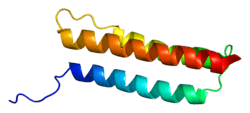BAG4
BAG family molecular chaperone regulator 4 is a protein that in humans is encoded by the BAG4 gene.[5][6][7]
Function
The protein encoded by this gene is a member of the BAG1-related protein family. BAG1 is an anti-apoptotic protein that functions through interactions with a variety of cell apoptosis and growth related proteins including BCL-2, Raf-protein kinase, steroid hormone receptors, growth factor receptors and members of the heat shock protein 70 kDa family. This protein contains a BAG domain near the C-terminus, which could bind and inhibit the chaperone activity of Hsc70/Hsp70. This protein was found to be associated with the death domain of tumor necrosis factor receptor type 1 (TNF-R1) and death receptor-3 (DR3), and thereby negatively regulates downstream cell death signaling. The regulatory role of this protein in cell death was demonstrated in epithelial cells which undergo apoptosis while integrin mediated matrix contacts are lost.[7]
Interactions
BAG4 has been shown to interact with:
References
- GRCh38: Ensembl release 89: ENSG00000156735 - Ensembl, May 2017
- GRCm38: Ensembl release 89: ENSMUSG00000037316 - Ensembl, May 2017
- "Human PubMed Reference:". National Center for Biotechnology Information, U.S. National Library of Medicine.
- "Mouse PubMed Reference:". National Center for Biotechnology Information, U.S. National Library of Medicine.
- Takayama S, Xie Z, Reed JC (Feb 1999). "An evolutionarily conserved family of Hsp70/Hsc70 molecular chaperone regulators". J Biol Chem. 274 (2): 781–6. doi:10.1074/jbc.274.2.781. PMID 9873016.
- Jiang Y, Woronicz JD, Liu W, Goeddel DV (Feb 1999). "Prevention of constitutive TNF receptor 1 signaling by silencer of death domains". Science. 283 (5401): 543–6. doi:10.1126/science.283.5401.543. PMID 9915703.
- "Entrez Gene: BAG4 BCL2-associated athanogene 4".
- Lau PP, Chan L (Dec 2003). "Involvement of a chaperone regulator, Bcl2-associated athanogene-4, in apolipoprotein B mRNA editing". J. Biol. Chem. 278 (52): 52988–96. doi:10.1074/jbc.M310153200. PMID 14559896.
- Miki K, Eddy EM (Apr 2002). "Tumor necrosis factor receptor 1 is an ATPase regulated by silencer of death domain". Mol. Cell. Biol. 22 (8): 2536–43. doi:10.1128/MCB.22.8.2536-2543.2002. PMC 133739. PMID 11909948.
External links
- Human BAG4 genome location and BAG4 gene details page in the UCSC Genome Browser.
Further reading
- Riley BM, Schultz RE, Cooper ME, et al. (2007). "A Genome-Wide Linkage Scan for Cleft Lip and Cleft Palate Identifies a Novel Locus on 8p11-23". Am. J. Med. Genet. A. 143 (8): 846–52. doi:10.1002/ajmg.a.31673. PMC 2570349. PMID 17366557.
- Yang ZQ, Streicher KL, Ray ME, et al. (2007). "Multiple interacting oncogenes on the 8p11-p12 amplicon in human breast cancer". Cancer Res. 66 (24): 11632–43. doi:10.1158/0008-5472.CAN-06-2946. PMID 17178857.
- Gerhard DS, Wagner L, Feingold EA, et al. (2004). "The Status, Quality, and Expansion of the NIH Full-Length cDNA Project: The Mammalian Gene Collection (MGC)". Genome Res. 14 (10B): 2121–7. doi:10.1101/gr.2596504. PMC 528928. PMID 15489334.
- Lau PP, Chan L (2004). "Involvement of a chaperone regulator, Bcl2-associated athanogene-4, in apolipoprotein B mRNA editing". J. Biol. Chem. 278 (52): 52988–96. doi:10.1074/jbc.M310153200. PMID 14559896.
- Al-Lamki RS, Wang J, Thiru S, et al. (2003). "Expression of Silencer of Death Domains and Death-Receptor-3 in Normal Human Kidney and in Rejecting Renal Transplants". Am. J. Pathol. 163 (2): 401–11. doi:10.1016/S0002-9440(10)63670-X. PMC 1868232. PMID 12875962.
- Eichholtz-Wirth H, Fritz E, Wolz L (2003). "Overexpression of the 'silencer of death domain', SODD/BAG-4, modulates both TNFR1- and CD95-dependent cell death pathways". Cancer Lett. 194 (1): 81–9. doi:10.1016/S0304-3835(03)00009-0. PMID 12706861.
- Strausberg RL, Feingold EA, Grouse LH, et al. (2003). "Generation and initial analysis of more than 15,000 full-length human and mouse cDNA sequences". Proc. Natl. Acad. Sci. U.S.A. 99 (26): 16899–903. doi:10.1073/pnas.242603899. PMC 139241. PMID 12477932.
- Briknarová K, Takayama S, Homma S, et al. (2002). "BAG4/SODD protein contains a short BAG domain". J. Biol. Chem. 277 (34): 31172–8. doi:10.1074/jbc.M202792200. PMID 12058034.
- Eichholtz-Wirth H, Sagan D (2002). "Altered signaling of TNFalpha-TNFR1 and SODD/BAG4 is responsible for radioresistance in human HT-R15 cells". Anticancer Res. 22 (1A): 235–40. PMID 12017295.
- Antoku K, Maser RS, Scully WJ, et al. (2001). "Isolation of Bcl-2 binding proteins that exhibit homology with BAG-1 and suppressor of death domains protein". Biochem. Biophys. Res. Commun. 286 (5): 1003–10. doi:10.1006/bbrc.2001.5512. PMID 11527400.
- Frisch SM (2000). "Evidence for a function of death-receptor-related, death-domain-containing proteins in anoikis". Curr. Biol. 9 (18): 1047–9. doi:10.1016/S0960-9822(99)80455-2. PMID 10508612.







